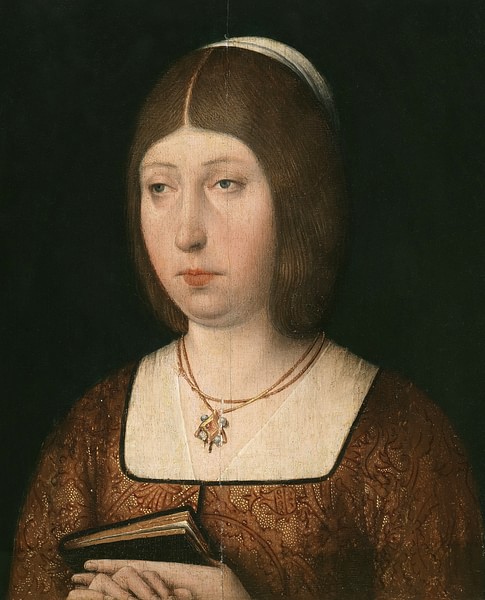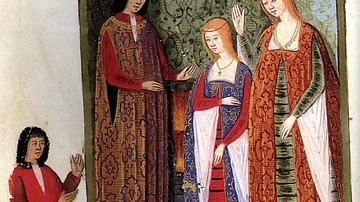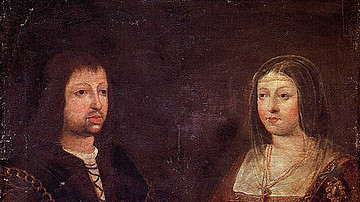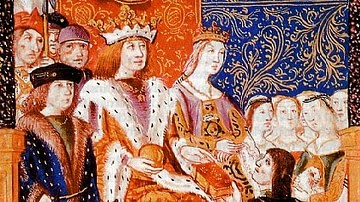
Isabella I of Castile (1451-1504), was Queen of Castile (r. 1474-1504) and of Aragon (r. 1479-1504) alongside her husband Ferdinand II of Aragon (1452-1516). Her reign included the unification of Spain, the reconquest of Granada, sponsoring Christopher Columbus in his voyage to explore the Caribbean, and the establishment of the Spanish Inquisition.
Early Life
Isabella was born 22 April 1451 in the town of Madrigal de las Altas Torres in Castile (which is now modern Spain) to John II of Castile (r. 1406-1454) and Isabella of Portugal (1447-1454). Despite having two brothers and spending much time with her mother in Arévalo where she participated in more ladylike activities, Isabella was soon drawn in and involved with the Castilian political world. While there were no laws against women being on the throne, Isabella was third in line because her brothers were higher up the succession line. The iron-willed and determined young woman was brought to the Court of Castile when she was in her early teenage years so that her father could keep an eye on her. Isabella was well-versed in Latin, and she studied history and theology, which furthered her religious convictions, which would be extremely influential in her actions as queen in the future.
Isabella's brother Enrique IV became king as Henry IV of Castile (r. 1454-1474), but discontent with his rule soon became vocalized as the kingdom was dissatisfied with his ineffective rule. Henry struggled with producing a legitimate heir, as his first marriage bore no children, and his only daughter, Juana (1462-1530), was believed to be an illegitimate child. He was unable to win back Granada, which had been under Muslim control since the mid-1200s, and had Jewish and Muslim advisors in place, damaging the image of Castile being a Christian kingdom.
To placate the nobles, Henry named his brother Alfonso (1453-1468) heir, but Alfonso had to marry his daughter so they could both rule. When Henry ultimately reneged on this deal and supported his daughter's claim, the nobles began their campaign to place Alfonso on the throne. When Alfonso died in 1468, of suspected poisoning, the nobles approached Isabella as she was also a legitimate candidate. She refused to take the crown and wished to wait for her brother to leave. Seeing this, Henry negotiated with the nobles and made Isabella his heir.
Marriage to Ferdinand
One of Henry's requirements of Isabella being his heir was that she needed Henry's consent to marry. Isabella rejected all of the suitors that Henry approved of and married Ferdinand II of Aragon (r. 1479-1516). To Isabella, a marriage with Ferdinand was the best for Castile as the marriage could possibly unite kingdoms from a similar region that had similar customs and laws. Isabella sent Henry a letter asking for his permission, but he never answered. Isabella did not let this deter her, and she married Ferdinand in 1469 without Henry's consent.
Henry and the nobles who did not want a man of Aragon in the Castilian court rejected Isabella's claim to the throne and attempted to name Henry's daughter, Juana, as heir. However, Isabella and the nobles on her side saw her royal lineage as an anchor to rule over Castile. Since many speculated Juana to be an illegitimate child, her bloodline was seen as inferior to that of Isabella, and she was not seen as a strong candidate. This division led to the War of Castilian Succession (1475-1479).
In 1474, two days after Henry's death, Isabella proclaimed herself queen. While Juana and her supporters had military resources from Portugal through Juana's marriage to Alfonso V of Portugal (1432-1481), Isabella and Ferdinand had little help. Isabella ultimately won this war of succession because of the disintegration of Portugal's economics and military base and the unexpected strength of the Castilian Army.
After securing the Castilian throne, Isabella and Ferdinand decided to join their respective domains; in 1479, Aragon and Castile were united, and the two ruled as joint monarchs. Isabella was perceived as an autonomous ruler, whose power stemmed from the strength of the Castilian throne. She ruled Castile in her own right, and Ferdinand was simply seen as her king-consort. The joint seal of Aragon and Castile had Isabella's arrows placed above Ferdinand's yoke, an indication of Isabella asserting her superiority as a ruler.
Isabella strove to be an independent ruler, and this is evident in the way her marriage and family life were handled. When Isabella and Ferdinand disagreed, she often chose to speak her mind and her opinion rather than staying quiet and cooperative as expected of women at the time. In 1469, Ferdinand and Isabella signed a Marriage Concession in which Ferdinand recognized that Castile belonged to Isabella, and she had direct and sole control of her domain. He also agreed that he would never separate the children from Isabella and that the monarchy's main residence would be in Castile. With these concessions, Castile and Aragon were united, and this was the beginning of the unification of Spain.
Spanish Inquisition & Reconquest
Isabella was a pious Catholic who wanted to build a united Christian kingdom, and so non-Christians were eventually kicked out of Castile. Many attributed the problems of the region now known as Spain to a lapse in Christian religious beliefs. To alleviate these fears, Isabella and Ferdinand established the Tribunal of the Holy Office of Inquisition, better known as the Spanish Inquisition, in 1478. The Inquisition was tasked with being a secret police force for the Crown, which also ensured power remained with the monarchy.
Isabella also initiated the extension of her and Ferdinand's authority over Alcántara, Calatrava, and Santiago. These territories were religious military orders and were governed typically by Castilian nobles who called themselves Grand Masters. These orders were being exploited by the Castilian nobility and there were extremely tense rivalries between those who wanted to become Grand Master. Through Isabella's initiative, Ferdinand became the Grand Master of Calatrava in 1487, and in the next few years, he became Grand Master of Alcántara and Santiago, thus giving the Crown of Castile authority over the three orders. This extension gave the Crown much control over the wealth of those areas and gave more land to Castile.
Isabella furthered her mission of creating a united Christian kingdom by finishing the Reconquista, which was a series of battles to recapture territory from the Muslims. The reconquest of Granada in 1492 completed this process. Driven by her support and allegiance to the Christian cause, Isabella did everything in her power to ensure Spanish victory. She financed the war and stayed with the armies giving them aid and moral support. When Ferdinand suggested that the military take a break from trying to conquer Granada and place more military emphasis on the weakened French border due to French-Aragonese tension, Isabella took charge and told Ferdinand that the armies would stay where they were to win Granada.
Age of Exploration
In Aragon, exploration of the Mediterranean and expansion had already begun. To counteract this and grow the prestige of Castile, Isabella supported Christopher Columbus (1451-1506). Many other European rulers had denied Columbus as they believed his plan to be outlandish and his calculations incorrect. This was a gamble for Isabella, as she alone decided to support Columbus, with all monetary funds coming from Castile: "I will assume the undertaking for my own Crown of Castile and am ready to pawn my jewels to defray the expenses of it, if the funds of the treasury shall be found inadequate!" (Jenkins, 117)
The gamble paid off; once Columbus brought news of the areas he explored in the Caribbean, only Castile had the right to trade with the new continent, and Pope Alexander VI (in office 1492-1503) made a decree in which Isabella and her heirs, independent of Ferdinand, would be given control of the New World.
Later Life & Legacy
Isabella took great pleasure not only in the religious world but the academic one as well. Unlike Ferdinand, Isabella was well accomplished in Latin, and she was also known to support well-known scholars. Many of the well-known literary works of the region at the time were dedicated to Isabella, such as those by Íñigo de Mendoza (c. 1422-1492), who wrote poems that compared Isabella to the Virgin Mary. Isabella supported the poet and cleric Ambrosio Montesino, who produced religious poems and music. In her life, Isabella was also a patron of many Spanish and Flemish artists and helped create a Hispano-Flemish art style through Juan De Flandes (1460-1519).
Towards the end of her reign, Isabella was plagued with family struggles. The eldest of her five children, Isabella (1470-1498) died during childbirth, and her grandson died a year after his mother. Her only son and heir, Juan (1478-1497), died of an illness. Her daughter Juana (1479-1555) was referred to as Juana the Mad because of her irritable and moody demeanor. Despite the speculations regarding Juana's sanity, after the death of her older siblings, she became Isabella's heir. Isabella's daughter Maria (1482-1517) would become Queen of Portugal, and her last daughter Catherine of Aragon (1485-1536) would become Queen of England and the first wife of Henry VIII of England (r. 1509-1547).
Isabella of Castile had a monumental impact on the world. She started the eventual unification of Spain and financially helped the exploration of the New World. Upon her death, the people of Castile mourned for the loss of a great queen. To this day, on the anniversary of her burial, bells toll to commemorate Isabella of Castile.












